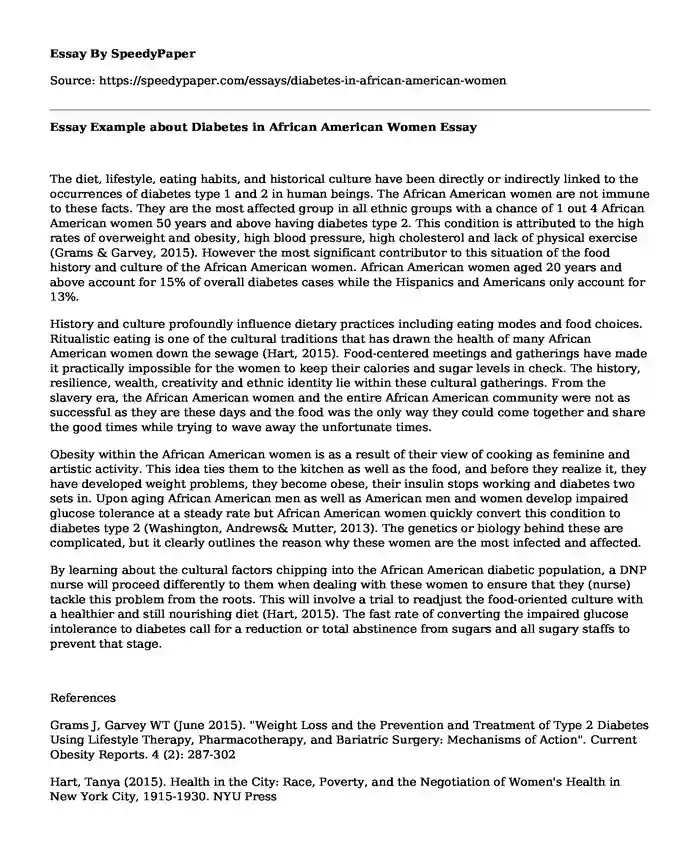The diet, lifestyle, eating habits, and historical culture have been directly or indirectly linked to the occurrences of diabetes type 1 and 2 in human beings. The African American women are not immune to these facts. They are the most affected group in all ethnic groups with a chance of 1 out 4 African American women 50 years and above having diabetes type 2. This condition is attributed to the high rates of overweight and obesity, high blood pressure, high cholesterol and lack of physical exercise (Grams & Garvey, 2015). However the most significant contributor to this situation of the food history and culture of the African American women. African American women aged 20 years and above account for 15% of overall diabetes cases while the Hispanics and Americans only account for 13%.
History and culture profoundly influence dietary practices including eating modes and food choices. Ritualistic eating is one of the cultural traditions that has drawn the health of many African American women down the sewage (Hart, 2015). Food-centered meetings and gatherings have made it practically impossible for the women to keep their calories and sugar levels in check. The history, resilience, wealth, creativity and ethnic identity lie within these cultural gatherings. From the slavery era, the African American women and the entire African American community were not as successful as they are these days and the food was the only way they could come together and share the good times while trying to wave away the unfortunate times.
Obesity within the African American women is as a result of their view of cooking as feminine and artistic activity. This idea ties them to the kitchen as well as the food, and before they realize it, they have developed weight problems, they become obese, their insulin stops working and diabetes two sets in. Upon aging African American men as well as American men and women develop impaired glucose tolerance at a steady rate but African American women quickly convert this condition to diabetes type 2 (Washington, Andrews& Mutter, 2013). The genetics or biology behind these are complicated, but it clearly outlines the reason why these women are the most infected and affected.
By learning about the cultural factors chipping into the African American diabetic population, a DNP nurse will proceed differently to them when dealing with these women to ensure that they (nurse) tackle this problem from the roots. This will involve a trial to readjust the food-oriented culture with a healthier and still nourishing diet (Hart, 2015). The fast rate of converting the impaired glucose intolerance to diabetes call for a reduction or total abstinence from sugars and all sugary staffs to prevent that stage.
References
Grams J, Garvey WT (June 2015). "Weight Loss and the Prevention and Treatment of Type 2 Diabetes Using Lifestyle Therapy, Pharmacotherapy, and Bariatric Surgery: Mechanisms of Action". Current Obesity Reports. 4 (2): 287-302
Hart, Tanya (2015). Health in the City: Race, Poverty, and the Negotiation of Women's Health in New York City, 1915-1930. NYU Press
Washington R.E., Andrews R.M. & Mutter R.L. (2013). "Emergency Department Visits for Adults with Diabetes, 2010". HCUP Statistical Brief 167. Rockville MD: Agency for Healthcare Research and Quality. Archived from the original on 2013-12-03.
Cite this page
Essay Example about Diabetes in African American Women. (2022, Jun 06). Retrieved from https://speedypaper.com/essays/diabetes-in-african-american-women
Request Removal
If you are the original author of this essay and no longer wish to have it published on the SpeedyPaper website, please click below to request its removal:
- Essay Example about Community Gatekeeper Identification
- Free Essay with an Interview with Patricia Florina, Clothing Store Owner, and Manager
- Comparison and Contrast Essay Sample: Caesar and Lincoln
- Essay Example: Enterprise Resource Planning Risk Mitigation
- Japanese Art: From Refined to Revered in Five Decades. Essay Sample
- Essay Sample on Significance of John F. Kennedy
- Nursing with Compassion - Free Essay Sample
Popular categories





